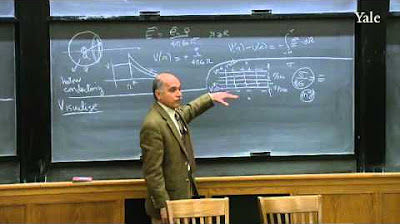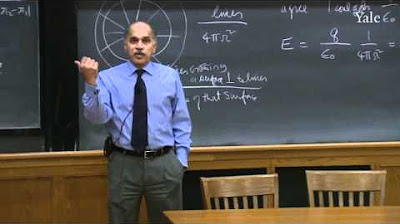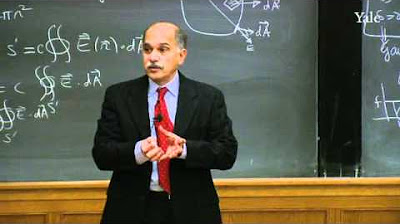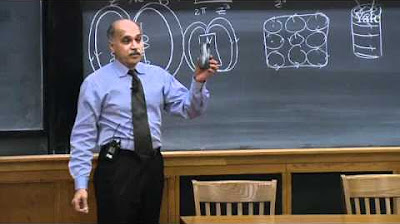5. The Electric Potential and Conservation of Energy
TLDRThe video script is an in-depth exploration of electrostatics, focusing on the concept of electric potential and its relationship with the electric field. The professor begins by discussing how to determine the trajectory of a moving charge within a static environment of fixed charges. The principle of superposition is introduced as a fundamental concept for calculating the electric field due to multiple charges. The script delves into the derivation of the law of conservation of energy in the context of electrostatics, emphasizing the importance of conservative forces and how they can be identified by their path independence. The professor illustrates the process of finding the potential energy and electric field due to a single charge and extends the discussion to multiple charges using the principle of superposition. The script concludes with an example of calculating the potential and field for a dipole, highlighting the ease of working with potentials rather than fields due to the scalar nature of potential functions. The lecture emphasizes the practicality of using potentials in electrostatics problems and the profound concept of energy conservation that remains valid even in quantum mechanics.
Takeaways
- 📐 **Electrostatics and Trajectory Calculation**: Understanding the behavior of a movable charge q in an environment with fixed charges can be achieved by calculating the electric field due to the fixed charges, which then allows the prediction of the movable charge's trajectory using Newton's laws.
- 🚀 **Force and Acceleration**: The force acting on a charge is determined by the electric field at the charge's location multiplied by the charge itself, which in turn can be used to find the acceleration of the charge.
- ⏲️ **Updating Position and Velocity**: By continuously updating the position and velocity of a charge based on its acceleration, one can plot its trajectory over time.
- 🔧 **Practical Computation Efficiency**: In practice, it's beneficial to use techniques like Gauss's law to simplify computations, especially for symmetrical geometries like spheres, cylinders, or planes.
- 🔥 **Work-Energy Theorem**: The work done by the force on a body is equal to the change in the body's kinetic energy, a principle derived from Newton's laws and calculus, which is applicable regardless of the specific type of force involved.
- 🧲 **Conservation of Energy**: In a closed system with conservative forces, the total mechanical energy (potential plus kinetic) remains constant, which is a powerful tool for solving physics problems.
- 🔄 **Path Independence**: The work done by a conservative force is independent of the path taken, which is a key characteristic that allows for the definition of potential energy.
- 🎢 **Roller Coaster Example**: The conservation of energy principle can be applied to complex systems like roller coasters to determine velocities at different points, despite the changing forces acting on the system.
- ⚖️ **Conservative Forces and Potential Energy**: Every conservative force can be expressed as the negative gradient of a potential energy function, and vice versa, which is a fundamental concept in physics.
- 🔎 **Deriving Electric Field from Potential**: For any given potential, one can derive the electric field by taking the gradient of the potential, which simplifies calculations, especially for systems with multiple charges.
- ⚡ **Electrostatic Force as Conservative**: The electrostatic force, like gravity, is conservative, which means that the work done by this force on a charge in moving between two points is path-independent and only depends on the end points.
Q & A
What is the principle of superposition in the context of electric fields?
-The principle of superposition states that the total electric field produced by a collection of charges is the vector sum of the electric fields produced by each charge individually. This principle is fundamental in electrostatics and allows for the simplification of calculations involving multiple charges.
How does one determine the force on a charge in an electric field?
-The force on a charge in an electric field is determined by multiplying the charge (q) by the electric field (E) at the location of the charge, following the formula F = qE, where F is the force experienced by the charge.
What is the significance of Gauss's law in electrostatics?
-Gauss's law is significant because it provides an efficient way to calculate the electric field for symmetrical charge distributions like spherical, cylindrical, or planar geometries. It is derived from Coulomb's law and allows for the calculation of the electric field by considering the flux through a closed surface, which simplifies the computation.
Why is the work-energy theorem useful in physics?
-The work-energy theorem is useful because it relates the work done by a force on an object to the change in the object's kinetic energy. It is a consequence of Newton's laws and provides a way to calculate the final velocity of an object when the force acting on it and the displacement are known.
How is the potential energy function (U) related to the force (F) in a conservative force field?
-In a conservative force field, the force (F) is related to the potential energy function (U) by being the negative gradient of U. This means that F = -∇U, where ∇ denotes the gradient operator. This relationship allows one to find the force from the potential energy or vice versa.
What is the condition for a force field to be conservative?
-A force field is conservative if and only if the line integral of the force around any closed path is zero. Mathematically, this is expressed as ∮F⋅dr = 0 for all closed paths. This condition ensures that the work done by the force in moving a particle around a closed loop is zero.
What is the difference between conservative and non-conservative forces?
-Conservative forces are those for which the work done in moving a particle between two points is independent of the path taken, and it is equal to the negative change in potential energy. Non-conservative forces, such as friction, do work that depends on the path taken, and they do not have a potential energy function associated with them.
Why is the law of conservation of energy important in physics?
-The law of conservation of energy is important because it is a fundamental principle that states that energy cannot be created or destroyed, only converted from one form to another. This law is applicable across all physical processes and is a cornerstone of the physical sciences, allowing for the analysis and prediction of system behavior.
How does one calculate the electric potential due to a point charge?
-The electric potential (V) due to a point charge is calculated by integrating the electric field (E) over the distance (dr) from the charge to the point of interest. For a point charge q, the electric potential at a distance r is given by V = (1/4πε₀) * (q/r), where ε₀ is the vacuum permittivity.
What is the relationship between the electric field and the electric potential?
-The electric field (E) is the negative gradient of the electric potential (V). This means that E = -∇V. By taking the derivatives of the potential with respect to spatial coordinates, one can find the components of the electric field at any point in space.
Why is it generally easier to calculate the electric potential first and then find the electric field, rather than the other way around?
-Calculating the electric potential first is easier because the potential is a scalar quantity, and the contribution of each charge to the potential at a point is simply additive. Once the potential is found, the electric field can be obtained by taking its gradient, which involves vector calculus but is generally more straightforward than calculating the field components directly from the charges.
Outlines
😀 Understanding Electrostatics and Trajectory Prediction
The first paragraph introduces the concept of electrostatics, where fixed charges (q_1, q_2, q_3) and a movable charge (q) are considered. It explains that by computing the electric field due to each charge, one can determine the force on the movable charge and predict its trajectory using Newton's laws. The principle of superposition is mentioned as a method to simplify calculations, and Gauss's law is highlighted as a useful addition to Coulomb's law for more efficient computation, especially for symmetrical geometries like spheres or infinite planes.
😉 Conservation of Energy in Newton's Laws
The second paragraph discusses the shortcut of using conservation of energy to solve physics problems, instead of directly integrating Newton's laws. The work-energy theorem is derived from Newton's laws, which states that the work done by a force on an object is equal to the change in the object's kinetic energy. The concept of potential energy is introduced, and it is shown that the force is the negative derivative of potential energy. The paragraph also clarifies why friction, which depends on velocity, does not have a potential energy associated with it.
🎢 Energy Conservation in Non-Conservative Forces
The third paragraph explores the application of energy conservation in scenarios involving non-conservative forces, such as a roller coaster. It emphasizes that even though we cannot predict the trajectory in quantum mechanics, the total energy is conserved. The discussion then shifts to two dimensions, where the work-energy theorem is derived, but it is noted that the work done by a force can depend on the path taken, which complicates the conservation of energy.
🚧 Path Independence and Conservative Forces
The fourth paragraph delves into the conditions for a force to be conservative, which requires the work done by the force to be path-independent. It is shown that the work done by a force in a closed loop must be zero for the force to be conservative. The paragraph also provides an example where the work done depends on the path, demonstrating that not all forces are conservative.
🔍 Identifying Conservative Forces
The fifth paragraph explains how to identify conservative forces by showing that the line integral of the force around a closed path is zero. It introduces the concept of the gradient of a potential function, stating that if a force is the negative gradient of a potential function, it is conservative. The paragraph also mentions that all conservative forces can be expressed in this way.
🔗 Conservative Forces and Potential Energy
The sixth paragraph further discusses the relationship between conservative forces and potential energy. It explains that the work done by a conservative force in moving from one point to another is equal to the difference in potential energy at those points. The concept of the gradient operator is introduced to find the force from a potential function, and it is shown that the potential difference is obtained by integrating the force.
🌐 Testing for Conservative Forces
The seventh paragraph outlines a method to test if a force is conservative by checking if the cross-derivatives of the force components are equal. This condition stems from the fact that if a force is derived from a potential function, then the mixed partial derivatives of that function must be equal. The paragraph also provides a simple example using the potential due to gravity to illustrate the concept.
📡 Superposition Principle and Electrostatic Force
The eighth paragraph applies the concept of conservative forces to electrostatics, noting that the electric field due to a single charge is conservative. It emphasizes the power of the superposition principle, which allows the electric field for multiple charges to be determined by summing the fields due to individual charges. The paragraph concludes by verifying that the electrostatic force meets the criteria for a conservative force.
🔋 Calculating Electric Potential and Field
The ninth paragraph focuses on calculating the electric potential and field due to a point charge. It demonstrates that the potential energy is proportional to the potential, which is found by integrating the electric field. The paragraph also shows how to derive the electric field from the potential by taking its gradient, which results in the familiar formula for the electric field of a point charge.
🤔 Simplifying Calculations with Potential
The tenth paragraph discusses the advantages of using electric potential over electric field for calculations. It points out that potential is a scalar quantity, making it easier to sum the potential contributions from multiple charges. The paragraph also illustrates this with the example of an electric dipole, showing how to calculate the potential and subsequently the electric field components more easily by starting with the potential.
🧲 Dipole Moment and Electric Field Calculation
The eleventh paragraph concludes the discussion with the calculation of the electric potential and field for an electric dipole. It defines the dipole moment and uses it to simplify the expression for the potential, which is then used to find the electric field components. The paragraph emphasizes the ease of calculating derivatives of the potential compared to directly summing vector fields, highlighting the practicality of using potential in electrostatics problems.
📝 Final Thoughts on Electrostatics Calculations
The twelfth paragraph wraps up the discussion by reiterating the process of calculating the electric field from the potential for any charge configuration, including dipoles. It emphasizes the long-distance property approximation used in the dipole calculation and invites students to verify the results with homework problems. The importance of starting with the potential and taking derivatives for easier calculations is reinforced.
Mindmap
Keywords
💡Electrostatics
💡Coulomb's Law
💡Principle of Superposition
💡Electric Field
💡Conservative Force
💡Potential Energy
💡Work-Energy Theorem
💡Line Integral
💡Divergence and Curl
💡Dipole
💡Gradient
Highlights
The concept of electrostatics is introduced with a focus on how to predict the behavior of a movable charge q in an environment with fixed charges.
The importance of computing the electric field due to multiple charges using the principle of superposition is emphasized.
Newton's law is used to determine the force acting on a charge and subsequently its acceleration and trajectory.
The student-teacher interaction highlights the importance of dt squared in the context of the discussion, showcasing active learning.
The difference between electrostatics and real-world scenarios where all charges are moving is clarified.
The principle of superposition is linked back to Coulomb's law, underlining its foundational role in understanding electrostatics.
Gauss's law is introduced as a more efficient method for calculating electric fields in symmetrical geometries.
The work-energy theorem is derived from Newton's laws, providing a shortcut for determining the velocity of a mass-momentum system.
Conservation of energy is discussed as a consequence of Newton's laws and its application in mechanical systems like springs is explained.
The limitation of applying conservation of energy to non-conservative forces, such as friction, is highlighted.
The potential energy is defined in relation to force, and the relationship between them is established.
The concept of a conservative force and the conditions required for a force to be conservative are explored.
The path independence of work done by a conservative force and its implications for deriving conservation laws are discussed.
The derivation of the electric field from potential energy is demonstrated using calculus, simplifying calculations in electrostatics.
The potential and electric field of a dipole are calculated, illustrating the ease of deriving fields from potentials.
The condition for the dipole approximation to hold is identified as the distance r being much larger than the dipole separation a.
The practical approach of calculating potential energy first and then deriving the electric field is advocated for its simplicity and efficiency.
Transcripts
5.0 / 5 (0 votes)
Thanks for rating:





